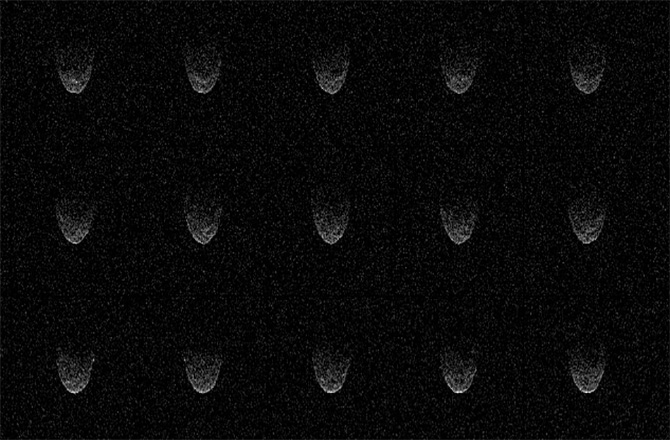.

This series of images was created when Arecibo in Puerto Rico bounced a radar signal off the asteroid 2006 SX 217. The echo of that signal was then received and decoded by the Green Bank Telescope in West Virginia.
.
Asteroids are in the news a lot these days, partially because we’re getting really good at detecting the flying chunks of space rock. But also, we’re pretty good at recording the impact of large meteors that seem to have a “thing” for hitting Russia.
However, as calls for improved detection techniques and asteroid impact mitigation strategies intensify, there’s one particularly worrisome class of asteroid that could hit us, unawares, in our blind spot — from the direction of the sun. But a celestial radar ‘tag team’ is on the case, having bounced radio waves off an asteroid that would have been invisible to optical telescopes.
Although asteroid 2006 SX 217 has a well-known orbit, on April 23, astronomers at the Arecibo Observatory in Puerto Rico took the opportunity to transmit radar pulses at the object as it made a close approach with Earth. Although Arecibo could transmit the radar, problems with the large dish’s receiver meant that the National Science Foundation's Goldstone radio telescope, located in West Virginia, had to step in to help out.
The space rock, which measures approximately a mile wide, came as close as 3 million miles from Earth (around 10 times the Earth-moon distance), but as it was approaching from the direction of the sun, the sun’s glare would have rendered any observation attempts by optical telescopes futile. The radar campaign, however, managed to resolve fantastic detail in the asteroid’s surface features, highlighting its boulder strewn landscape.
After pinging 2006 SX 217, astronomers noticed that the asteroid was abnormally dark and larger than previous estimates suggested.
“This asteroid is really big and its surface is probably about as black as the toner in a copier,” said Arecibo astronomer Ellen Howell, who led the observation campaign. “It’s also slowly rotating, with one side moving toward Earth and the other away.”
Radar observations are critical in efforts to observe and characterize near-Earth asteroids. The resolution of the bounced radio waves not only provides an unparalleled view of asteroids’ surface features, the technique can be used to study Earth-buzzing asteroids even if we are otherwise blinded by the sun.
Quelle: D-News
